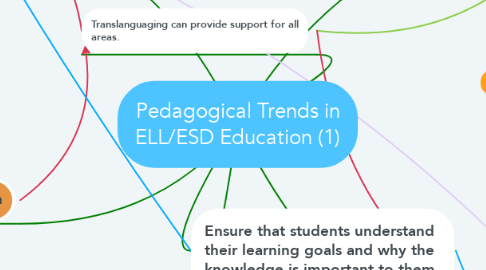
1. Literacy Development
1.1. Provide opportunities for the students to see themselves in their learning
1.1.1. Get students to take pictures and work with them on making dual-language translations of what is going on in their photos (Pacheco & Miller, 2015).
1.2. Teach things like text features so that readers can pick up meaning from context clues
1.3. Ensure that visuals are used so that meaning can be derived from text.
1.4. Explicitly teach new vocabulary structures
1.5. Teach students to look for patterns in words. Consider teaching them word families or grammar structures.
1.6. Practice. All of these skills need daily reinforcement in multiple areas.
2. Translanguaging can provide support for all areas.
3. Research
3.1. It's surprising that the research in this field has only really taken off in the last 20 or so years (Goldenberg, 2013).
3.2. ELLs need additional explicit instruction, even if they appear to be conversationally proficient (Goldenberg, 2013).
3.3. Having some instruction is better than no instruction (Saunders, Goldenberg, & Marcellett, 2013).
4. Ensure that students understand their learning goals and why the knowledge is important to them.
5. Works Cited
5.1. Colorin Colorado, (n.d.) Oral Language Development for Beginners. Retrieved from: https://www.colorincolorado.org/article/oral-language-development-beginners
5.2. Goldenberg, C. (2013). Unlocking the Research on English Language Learners. American Education, 37(2), 4-11. Retrieved from: https://files.eric.ed.gov/fulltext/EJ1014021.pdf
5.3. Pacheco, M.B., & Miller, M.E. (2015). Making Meaning Through Translanguaging in the Literacy Classroom. The Reading Teacher, 69(5), 533-537. DOI:10.1002/trtr.1390
5.4. Saunders, W., Goldenberg, C., & Marcelletti, D. (2013). English Language Development Guidelines for Instruction. American Education, 37(2), 13-25. Retrieved from: https://www.aft.org/sites/default/files/periodicals/Saunders_Goldenberg_Marcelletti.pdf
5.5. Sider, S., & Maich, K. (2014). Assistive Technology Tools: Supporting Literacy Learning for All Learners in the Classroom. What Works: Research into Practice, 50, 1-4. Retrieved from:http://www.edu.gov.on.ca/eng/literacynumeracy/inspire/research/WW_TechnologyTools.pdf
6. Technology
6.1. Flexibility in learning
6.2. Can be cumbersome due to access barriers (lack of training for teachers/students, or don't have access to the supplies needed for use. (Sider & Maich, 2014)
6.2.1. Support for technology if it does not work is also limited and can be very frustrating for educators/students to deal with
6.3. More practice opportunities
6.4. More possibilities for collaboration beyond what can occur in the classroom
6.5. So many options means that they can be tailored to the needs of the individual
6.5.1. Also the way that the future is going towards in terms of digital literacy
6.6. Speech to Text and Text to Speech Programs
6.6.1. Mixed research on usefulness but could potentially be helpful, especially for ELL students with exceptionalities.
6.6.2. Allow students the ability to slow down reading/writing at their own pace. Could reduce anxiety surrounding language learning.
7. Oral Language
7.1. Using things like Total Physical Response (TPR), can help strengthen the connection between learning by including a physical response or gesture to help it stick in their minds. (Colorin Colorado, n.d.)
7.2. Encourage students to take risks to promote resilience
7.2.1. If they're too hesitant design language activities that are meant to gently fail. Then scaffold it so that you can show them how to overcome that failure so that they are not afraid to try new things.
7.3. Practice, practice, practice. Authentic practice is key for students to feel more comfortable using the language.
7.4. Do more listening and less speaking as a teacher. Your students should be the ones engaged in meaningful conversations the majority of the time.
7.4.1. Provide conversation prompts to help guide students that are not sure how to begin
7.4.2. Use different group conversation strategies like philosophical chairs, or the snowball discussion.
